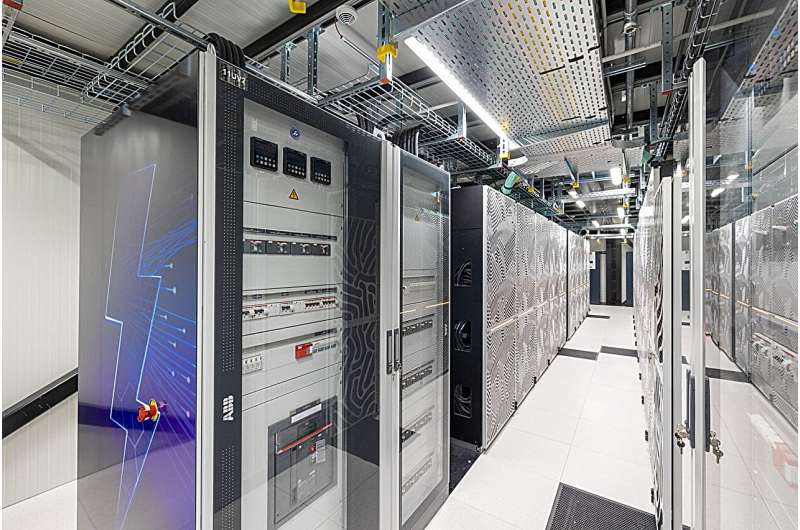
View between the racks of JUPITER. Credit: Forschungszentrum Jülich / Sascha Kreklau
A research team at the Jülich Supercomputing Center, together with experts from NVIDIA, has set a new record in quantum simulation: for the first time, a universal quantum computer with 50 qubits has been fully simulated—a feat achieved on Europe’s first exascale supercomputer, JUPITER, inaugurated at Forschungszentrum Jülich in September.
The result surpasses the previous world record of 48 qubits, established by Jülich researchers in 2022 on Japan’s K computer. It showcases the immense computational power of JUPITER and opens new horizons for developing and testing quantum algorithms. The research is published on the arXiv preprint server.
Quantum computer simulations are vital for developing future quantum systems. They allow researchers to verify experimental results and test new algorithms long before powerful quantum machines become reality. Among these are the Variational Quantum Eigensolver (VQE), which can model molecules and materials, and the Quantum Approximate Optimization Algorithm (QAOA), used for optimization problems in logistics, finance, and artificial intelligence.
Pushing the limits of classical computing
Simulating a quantum computer on conventional hardware is an enormous challenge. The number of possible quantum states increases exponentially: each additional quantum bit, or qubit for short, doubles both the computing and memory requirements.
While around 30 qubits can still be handled on a standard laptop, simulating 50 qubits demands around 2 petabytes—roughly two million gigabytes—of memory. “Only the world’s largest supercomputers currently offer that much,” says Prof. Kristel Michielsen, Director at the Jülich Supercomputing Center. “This use case illustrates how closely progress in high-performance computing and quantum research are intertwined today.”
The simulation replicates the intricate quantum physics of a real processor in full detail. Every operation—such as applying a quantum gate—affects more than 2 quadrillion complex numerical values, a “2” with 15 zeros. These values must be synchronized across thousands of computing nodes in order to precisely replicate the functioning of a real quantum processor.

Overview of JUPITER’s quad GH200 node design with included technology and bandwidths. Each node contains four GH200 superchips, each comprising a tightly integrated CPU–GPU pair. Credit: arXiv (2025). DOI: 10.48550/arxiv.2511.03359
Breakthrough enabled by new memory technology
The record was made possible by the close coupling of central processing units (CPUs) and graphics processing units (GPUs) in NVIDIA GH200 Superchips, which are used in the JUPITER supercomputer. This design allows data that exceed GPU memory limits to be temporarily stored in CPU memory with minimal loss of performance.
To exploit this hybrid memory system, specialists at the NVIDIA Application Lab—a initiative between the Jülich Supercomputing Center (JSC) and NVIDIA—enhanced Jülich’s simulation software Jülich Universal Quantum Computer Simulator (JUQCS). The new version, JUQCS-50, now performs quantum operations efficiently even when parts of the data are offloaded to the CPU.
Further innovations include a byte-encoding compression method that reduces memory requirements eightfold and a dynamic algorithm that continuously optimizes data exchange between more than 16,000 GH200 Superchips.
“With JUQCS-50, we can emulate universal quantum computers with high fidelity and tackle questions that no existing quantum processor can yet solve,” says Prof. Hans De Raedt of the Jülich Supercomputing Center and lead author of the study published as a preprint.
Integration into Jülich’s quantum infrastructure
JUQCS-50 will also be accessible to external research institutions and companies via JUNIQ—the Jülich UNified Infrastructure for Quantum Computing. It will serve both as a research tool and as a benchmark for future supercomputers.
The development took place within the framework of the JUPITER Research and Early Access Program (JUREAP). “Through early collaboration, hardware and software could be co-designed during JUPITER’s construction phase, in close cooperation between Jülich experts and NVIDIA—an important step toward realizing the full potential of this exascale system,” explains Dr. Andreas Herten, a member of the Jülich JUPITER project team and co-author of the study.
More information:
Hans De Raedt et al, Universal Quantum Simulation of 50 Qubits on Europe’s First Exascale Supercomputer Harnessing Its Heterogeneous CPU-GPU Architecture, arXiv (2025). DOI: 10.48550/arxiv.2511.03359
Journal information:
arXiv
Provided by
Jülich Research Centre
Citation:
First full simulation of 50-qubit universal quantum computer achieved (2025, November 11)
retrieved 11 November 2025
from https://phys.org/news/2025-11-full-simulation-qubit-universal-quantum.html
This document is subject to copyright. Apart from any fair dealing for the purpose of private study or research, no
part may be reproduced without the written permission. The content is provided for information purposes only.
